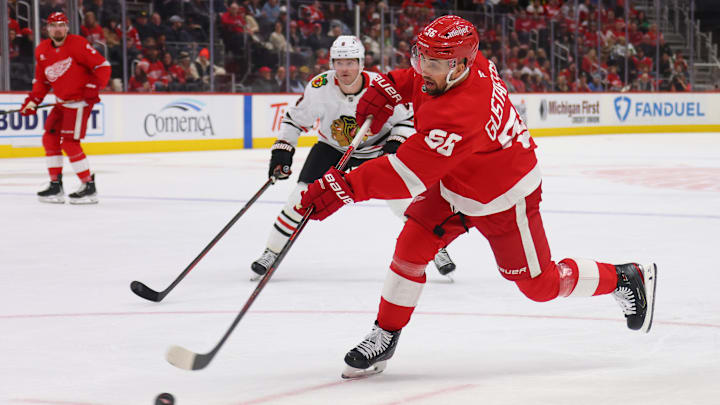Things that are constant, death, taxes, and the Detroit Red Wings needing offesnive help from their blue line.
This offseason, the Red Wings swapped one offensively-minded defenseman in Shayn Gostisbehere for Erik Gustafsson. The two are pretty comparable, but fans love debating which defenseman they would rather have on their team.
Likely for Steve Yzerman, general manager of the Detroit Red Wings, it came down to contract length. Gustafsson willingly signed on for just two seasons, while Gostisbehere commanded three years with the Carolina Hurricanes. Dollar-wise, the contracts were pretty close: $2 million for Gustafsson versus $3.2 million for Gostisbehere. Maybe, Gostisebehere preferred Carolina or Yzerman found more value in the Gustafsson contract, but who knows?
At the end of the day, Detroit signed Gustafsson and he was a tale of two seasons.
Detroit Red Wings offensive defenseman Erik Gustafsson played well after Todd McLellan took over
Although the first half of the season existed for Gustafsson, I can't help but throw his performance out the window. Maybe the first half Gustafsson will resurface next season, but I'm confident that we will likely see more of the second half Gustafsson than the first half Gustafsson. McLellan seems to have brought the best out of Gustafsson.
Gustafsson was signed to help the Detroit Red Wings’ power play. There was minimal hope for his help at even strength, and most fans thought Gustafsson would play a sheltered role.
Per the NHL website, the Red Wings finished fourth in the league based on the power play percentage (behind only the Winnipeg Jets, Vegas Golden Knights, and New Jersey Devils). Gustafsson factored into the power play nine times, which is a bit underwhelming given he was eighth on the team in power play time on ice. I will admit, the eye test wasn’t pleasing, either.
However, when Gustafsson went down with an injury, the Detroit Red Wings’ entire lineup suffered, especially the power play. Even with Gustafsson's lack of visual impact and the absence of statistics to reflect his importance on the power play, his absence was noticeable. Whether it was simply a correlation rather than cause and effect remains to be seen, but all I know is that the power play looked far more dangerous with Gustafsson in the lineup than when he was out of it.
Outside of the power play, when he was out with injury, the Wings did not struggle with finding defensive pairings that worked.
We can all nag on him for his lack of impact when he was playing for the Red Wings, but Gustafsson made more of a positive impact than we might have realized.
He will not knock socks off or play the most or toughest minutes, but he was an important player for the Detroit Red Wings. Of all players who were changed with Todd McLellan coming in as head coach of the Red Wings, Gustafsson might have had the biggest turnaround, but other players had big turnarounds, too.
Grade: B
Funny enough, before the injury, I would have likely assigned Gustafsson a C or C+. After seeing his teammates try to fill his shoes, I wonder if I might have been too harsh on Gustafsson. It’s clear that he helps the Detroit Red Wings’ power play and provides much-needed depth on the blue line. Gustafsson had a strong second half of the season, and I’m interested in watching more from him next season, especially with McLellan coaching him.
